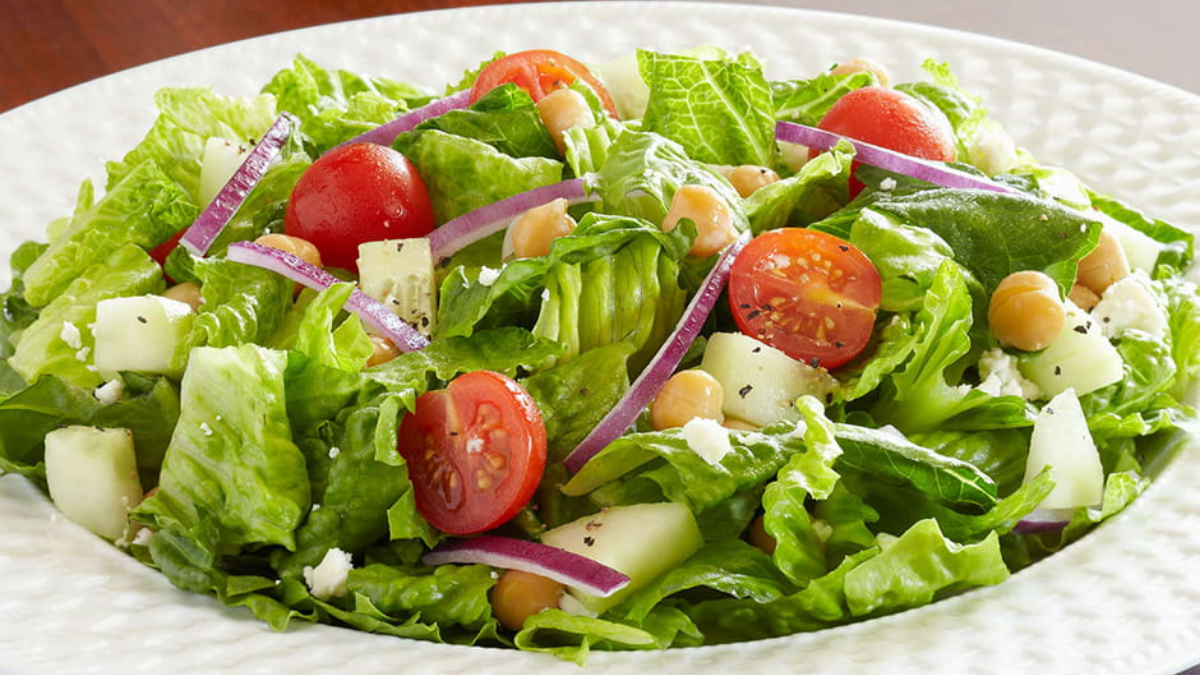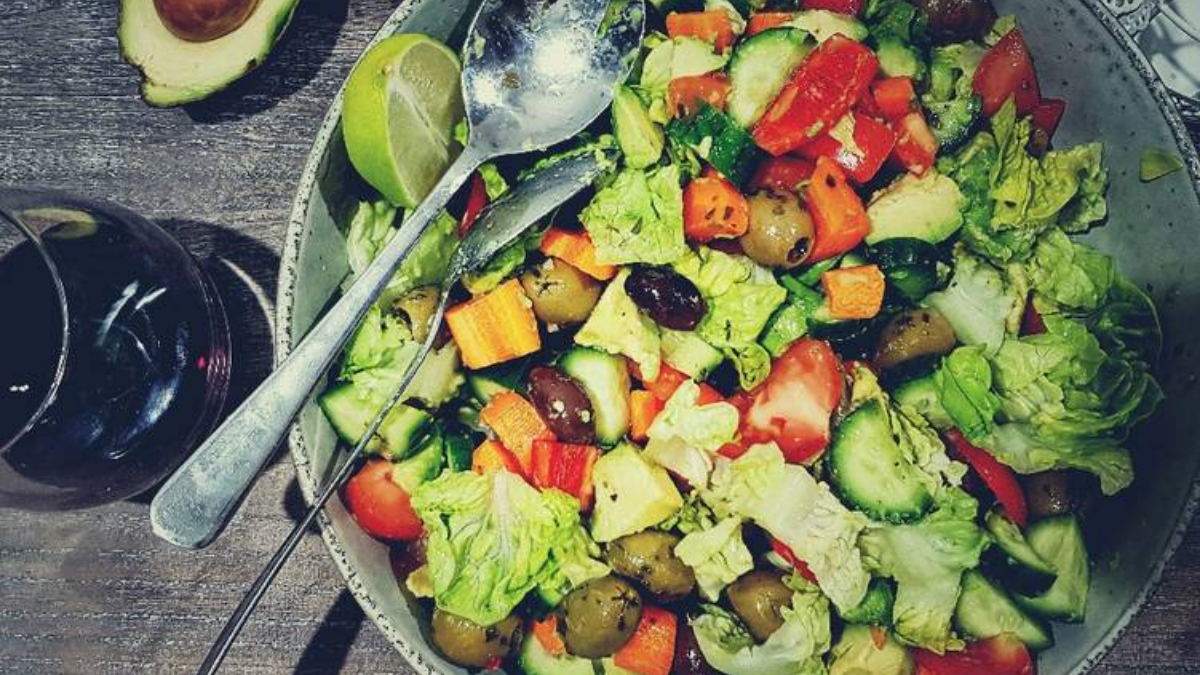The homemade garden salad is quick and easy, delicious, and reviving. It’s stuffed with fresh garden vegetables, crunchy croutons, and crisp leafy greens that have all been mixed with your choice of salad dressing. Serve this vibrant, healthful salad as a side dish to any supper main or as a light lunch with added protein. With a lighter, healthier dressing, this salad has all the flavor of some of your favorite restaurant-style salads. It’s a traditional salad that everybody enjoys.
This salad truly shines, thanks to the dressing. It is created with ingredients I always have in my cupboard, like olive oil, vinegar, lemon juice, and other herbs. By omitting mayo, this dressing recipe is also lighter. It is a straightforward recipe for a tossed salad that is lower in calories yet still flavorful.
In a food processor or blender, combine olive oil, Parmesan cheese, white wine vinegar, lemon juice, fresh parsley, salt, pepper, garlic, and Italian seasoning. To blend the ingredients, pulse a few times.
What is Exactly Garden Salad?
The main component of a garden salad, also known as a tossed salad, is a combination of raw vegetables. Croutons and salad dressing are two non-vegetable elements that could be used. The chilly dish is typically consumed before the main dinner and might occasionally be eaten in place of an entree.
Vegetable availability might differ from one area to another, implying that the ingredients in this particular salad may change. A garden salad is typically seen as a basic salad, lacking unusual components and typically made up of inexpensive, readily available materials.
Lettuce makes up the majority or base of the garden salad, and iceberg lettuce is typically the most widely used kind for this dish. Some people choose to use different ingredients instead, including mixed greens, and this version is frequently found in upscale dining establishments.
Typically, carrots are added to the base, and these can be chopped into matchstick-sized pieces, shredded, or round-sliced. Another frequent food that may be served in various ways is tomatoes, and large tomatoes can be diced, sliced, or cut into wedges. Cherry tomatoes, which can be served whole or sliced in half, are preferred by certain people.
How to Make Garden Salad?
Here is the easy way to make the garden salad:
Ingredients
- 6 cups spring greens salad mix
- 1 cup corn kernels
- One Persian cucumber, thinly sliced
- One beet, roasted
- 1/2 cup chopped sun-dried tomatoes
- Four watermelon or breakfast radishes, thinly sliced
- Two hearts of palm, cut into thin circles
- a handful of edible flowers, optional
- for the dressing:
- Six tablespoons of olive oil
- Two tablespoons of white wine or champagne vinegar
- One tablespoon of lemon juice
- Two teaspoons of dijon mustard (mild)
- One garlic clove, minced
- 1/2 teaspoon dried basil
- 1/2 teaspoon dried oregano
- 1/2 teaspoon kosher salt
Preparation
For the salad:
- In a large bowl, mix the salad greens and vegetables. Toss with the dressing to combine well. Garnish with edible flowers, if desired.
For the Dressing
- Place all ingredients in a mason jar and shake vigorously (this is a fun job for kids) or whisk in a bowl.
- Dressing can be stored in the refrigerator for up to 9 days.
Salad Variations
A good garden salad recipe is always adaptable. You can customize it any kind of way you’d like. Here are a few of my favorite ways to change up this salad to make it even more enjoyable:
Why you’ll Love this Garden Salad?
You will love this garden salad because it is:
- Quick and easy. Chopped salads are the best because they are so easy to make. All it takes is some chopping effort, then throw it all together, pour on some dressing, and toss to combine. Salads are always my go-to for a quick lunch or side because it’s ready once all the ingredients are prepped.
- Healthy and nutrient-dense. All these fresh vegetables make for a healthy salad packed with nutrients and clean energy to keep you going.
- Easy to customize. Don’t like what you see? No problem. Use this garden salad recipe as a base, and customize your salad to your liking with your favorite veggies, greens, and salad toppings. You can even pick any dressing that you want. Try Italian dressing, Greek salad dressing, or ranch dressing.
Tips for Keeping the Garden Vegetables Fresh
Because they have a chance to ripen on the vine fully, fresh garden vegetables are perfect for your garden salad dishes. If you’ve picked a tomato from the garden right before eating it, you know how much the flavor of such tomatoes differs from those found at the supermarket. As a result, you are also aware of how rapidly fresh garden produce can go bad. The following advice will help you keep them fresh until it’s time to make your salads or utilize them in any other meal.
- Keep most vegetables in their whole form as long as possible
- Refrigerate only after the product has been cut or prepared for use in recipes or snacks
- Use paper towels or a kitchen towel at the bottom of a storage container to help keep fresh lettuce and greens crisp longer
- Submerge chopped carrots and celery in cool water to refrigerate and make it last longer for snacking
- Wrap herbs in a slightly damp paper towel to help keep them fresh longer
What are the Health Benefits of Eating Salad?
Here are the health benefits of eating salad:
Good for Eyes
Yes, salads do help to improve your vision. Zeaxanthin, lutein, and other vitamin A carotenoids are abundant in spinach, red lettuce, and a few other vegetables. These nutrients protect your body from the intense light that would have harmed your eyes. If you don’t want to spend the rest of your life wearing glasses, include them in your daily diet.
Helps you Sleep Well
Have issues fallen asleep? According to a study, eating salad regularly keeps you healthy and helps with sleeplessness. Lettuce has a lot of lactucarium, a chemical that induces sleep and has been used to treat insomnia. Consider including it in your everyday diet.
Lowers Calorie Count
Consuming fried foods high in sugar increases your body’s calorie intake. You’ll be astonished at how many calories you burn off if you eat salads. The catch is that dressings and fried items are not required in salads. Include foods that are healthy for your body and have a high nutritional value.
Adds Fibre to the Body
Your body does require a lot of fiber. Consuming nutritious foods makes the body feel more energized. Salads increase dietary fiber, which significantly lowers cholesterol and constipation. When you eat high-fiber salads before a meal, you can eat more of the higher-calorie dishes provided later.
Increases Vegetable Intake
By regularly consuming a variety of salads, you may increase the number of vegetables in your diet the most effectively. The enzymes in raw vegetables will help you if you consume many of them. These enzymes aid in the body’s absorption of the nutrients in food, resulting in improved health.
Good for Digestion
You frequently experience extreme fullness after eating a substantial meal, followed by bloating. Salads don’t bloat you, which is their best quality. Salads keep you full and are undoubtedly satisfying, but they don’t make you feel sluggish like many meals do.
Sheds off the Extra Pounds
You need to eat salads daily if you’re seeking a quick strategy to lose weight around your waist. Salads have a lot of nutrients and very few calories. So you can substitute salads for all the greasy things. In just a few weeks, you will see the change.
Boosts Immune System
Salads are the best way to strengthen your immune system and keep you healthy. Regular salad consumption is an excellent method to enhance your intake of vegetables while bolstering your immune system, thanks to the salad’s antioxidant content.
How to Keep your Garden Salad Crisp When Packing for Lunch?
Making quick meals is one of the major obstacles to eating healthily. I like salads for lunch, but I’m aware that if you prepare them ahead of time, it might be difficult to keep them fresh. It makes a delicious lunch choice when you top this dish with a small serving of grilled chicken or tuna. Given how great this is, I wanted to share with you some of the finest methods for preparing those salads to prevent soggy greens when it’s time to eat.
- Create salads in a jar. Put the dressing on the bottom of a jar, and then add your toppings, with greens being added last to keep things crisp. Just pour onto a plate when ready to eat, and toss with your fork to coat with dressing.
- Wash and prep greens for salads, but wrap them in paper towels within your storage container and keep them separate from your chopped vegetable toppings. Store your toppings separately and assemble them at meal time.
Conclusion
Your taste buds will dance when you eat this garden salad. A wide variety of flavors enhances each bite as it comes together flawlessly. You’ll like eating this salad every day, allowing you to catch up on all the vegetables your body needs while reviving you with the flavor of the garden.
Making this salad is simple. All seasons of the year, these vegetables are sold in supermarkets. Additionally, visit a farmer’s market to find the freshest ingredients if you’re making it in the summer. The best part about salads is that you can make them your own by choosing your favorite lettuce, vegetables, protein, toppings, and dressing. Unquestionably, it offers the most opportunities for customization of any meal.
In terms of health foods, a chopped, blended, and tossed salad with lots of vegetables may not be groundbreaking, but what exactly makes a salad so beneficial? Your intake of nutrients will increase significantly if you eat a salad daily. You can count on your salad to contain some vitamins, minerals, and other nutrients, though the number of nutrients you obtain will mostly depend on the ingredients you choose.


